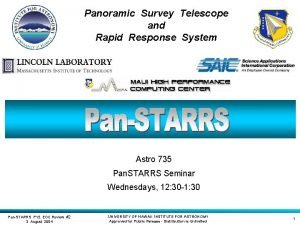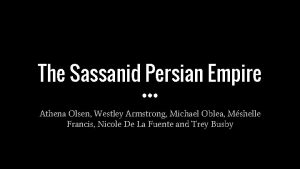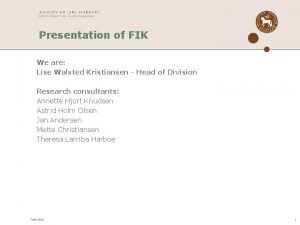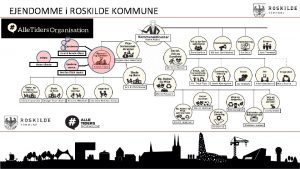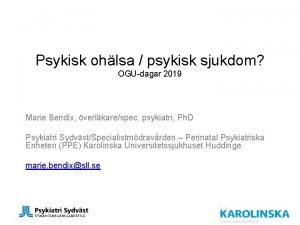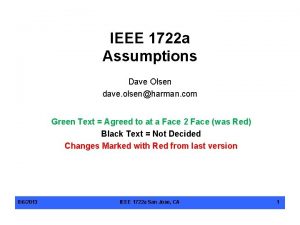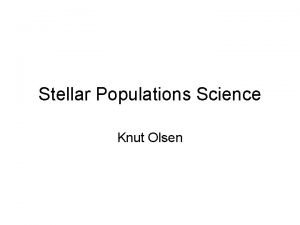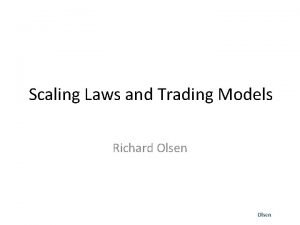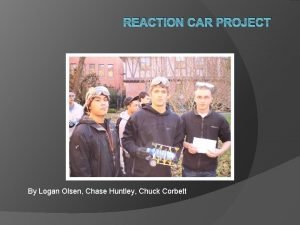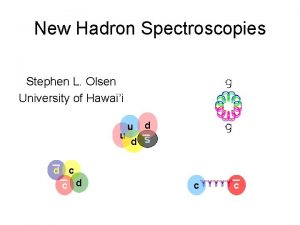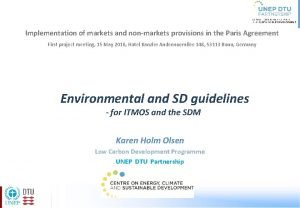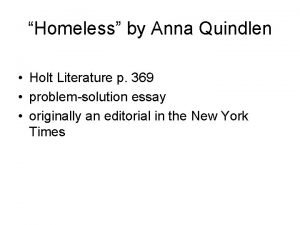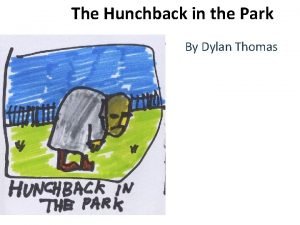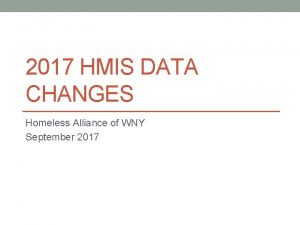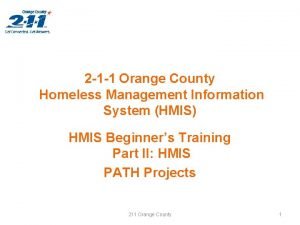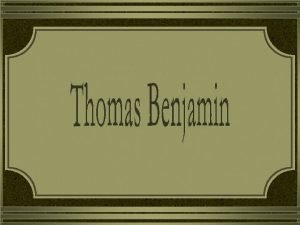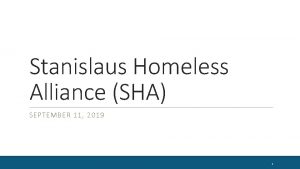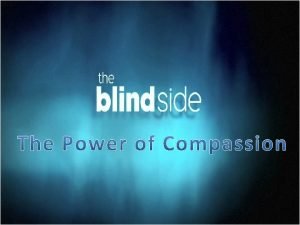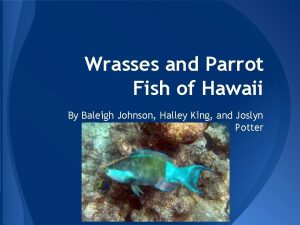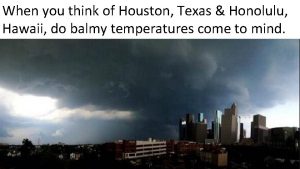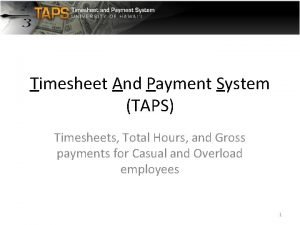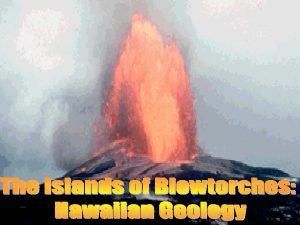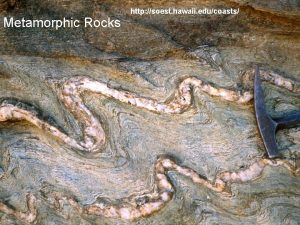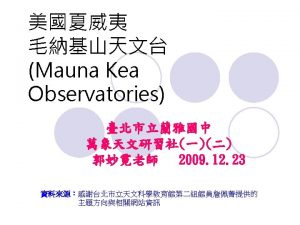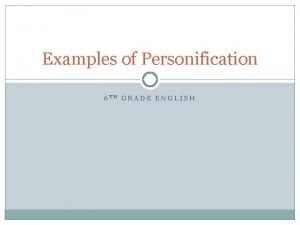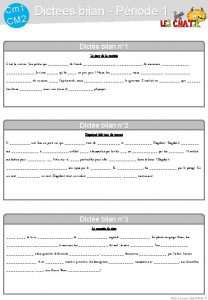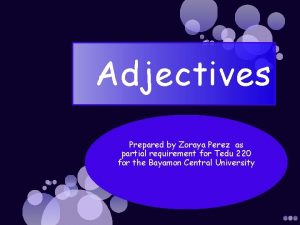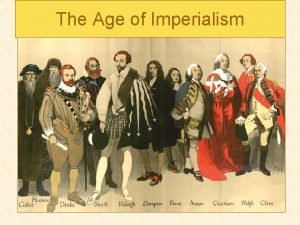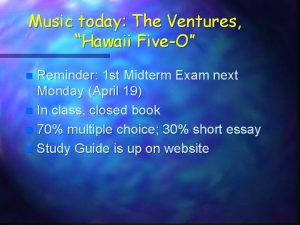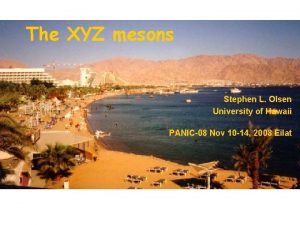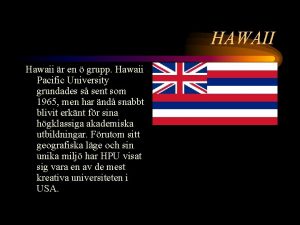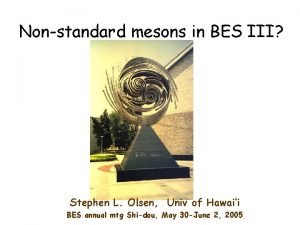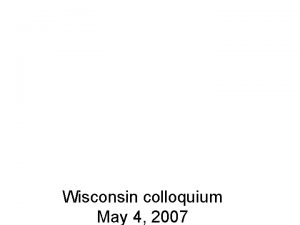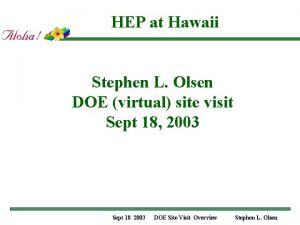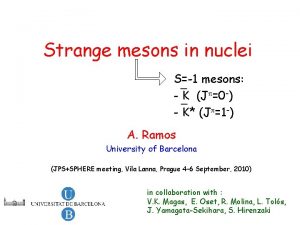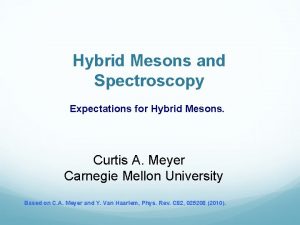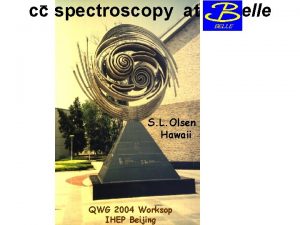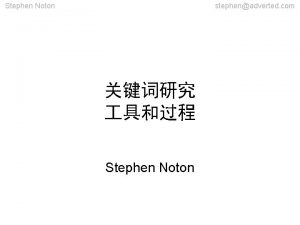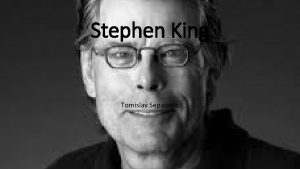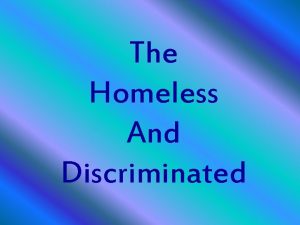Homeless mesons Stephen L Olsen University of Hawaii






































































- Slides: 70

Homeless mesons Stephen L. Olsen University of Hawai’i X 38 72 Y 4260 Y 3940

History: (sub-atomic particles) 1932: proton & neutron. . all we need? ? ? Joliet-Curie 1937: muon “Who ordered that? ” Rabi 1947: pion predicted in 1935 Yukawa Fermi 1950’s: , , , … “Had I foreseen that, I would have gone into botany” – Fermi Peters Jones Ting chadwick

Hadron “zoo” mesons baryons

Quarks restore economy (& rescue future Fermis from Botany? ) Gell-Mann 3 quarks u+2/3 Zweig d-1/3 u-2/3 s-1/3 Baryons: qqq p: p: u+2/3 d-1/3 u-2/3 d+1/3 (& 3 antiquarks) d+1/3 s+1/3 Mesons: q q +: u+2/3 d+1//3 -: u-2/3 u+2/3

Fabulously successful, but… • quarks are not seen • why only qqq and qq combinations? • What about spin-statistics?

W- s-1/3 three s-quarks in the same quantum state Das ist verboten!!

The strong interaction “charge” of each quark comes in 3 different varieties O. Greenberg Y. Nambu Ws-1/3 the 3 s-1/3 quarks in the W- have different color charges & evade Pauli

QCD: Gauge theory for color charges Yang Mills QED Nambu Fritzsch & Gell. Mann generalization of QED scalar charge: e QCD isotriplet charge: QED gauge Xform +ie. A 1 vector field (photon) er eb eg QCD gauge Xform + i a li Gi eight 3 x 3 SU(3) matrices 8 vector fields (gluons)

Attractive configurations eijk eiejek i≠ j≠k dij ei ej same as the rules for combining colors to get white: add 3 primary colors or add color+complementary color quarks: eiejek color charges antiquarks: ei ej ek anticolor charges Hence the name: Quantum Chromodynamics

Difference between QED & QCD QED: photons have no charge QCD: gluons carry color charges gluons interact with each other a Coupling strengths distance

Test QCD with 3 -jet events (& deep inelastic scattering) as gluon rate for 3 -jet events should decrease with Ecm

“running” as Why are these people smiling?

Probe QCD from other directions Proposed non-qq or non-qqq hadron spectroscopies: Pentaquarks: e. g. an S=+1 baryon u d s (only anti-s quark has S=+1) Glueballs: gluon-gluon color singlet states Multi-quark mesons: qq-gluon hybrid mesons u c c

Pentaquarks “Seen” in many experiments but not seen in just as many others Belle BES Ba. Bar CDF High interest: 1 st pentaquark paper has ~500 citations

Experimental situation is messy (some contradictory experiments) + ® γp Ks K n Counts/4 Me. V SAPHIR (2004) 4. 8 CLAS (2005) Same reaction M(n. K+)(Ge. V)

Some groups contradict themselves CLAS-D (2003) CLAS (2005) 5. 2 ? ? ? no signal

Pentaquark Scoreboard Positive signals Negative results Also: Belle Compass L 3 CLAS Yes: 17 No: 18

Plenary speaker at LP 05 Volker D Burkert Jefferson Lab “The Q pentaquark is not in good health, but it is still alive. ” -

This talk: non-standard mesons u c c u with “hidden charm” (i. e containing c & c) c c • standard cc mesons are: – best understood theoretically – narrow & non overlapping • c + c systems are commonly produced in B meson decays. c Vcb c b W- cosq. C CKM favored s

Thanks to KEKB we have lots of B mesons (>1 M BB pairs/day) >1 fb -1/day Design: 10 34

Primer on Charmonium

Charmonium mesons formed from c- and c-quarks c r c c-quarks are heavy: mc ~ 1. 5 Ge. V 2 mp velocities small: v/c~1/4 non-relativistic QM applies

QM of cc mesons c r c What is V(r) ? ? derive from QCD quantum chromodynamics

“Cornell” potential c r ~0. 1 fm c slope~1 Ge. V/fm “confining” large distance component V(r) G. S. Bali hep-ph/0010032 2 parameters: slope & intercept 1/r “coulombic” short distance component

Charmonium spectrum

1 -- Charmonium states Directly accessible via e+e- annihilation e+ e- J/ ’ (e+e- hadrons) ” “narrow” “wide” (G~300 Ke. V) (G~100 Ke. V) (G~25 Me. V) D-meson + anti-D meson mass threshold ” DD decay channel is open G(DD) 25 Me. V

P-wave states Gamma energy spectrum from ’ g X decays accessible via E 1 transitions from ’ Gaiser et al (Crystal Ball) PRD 34 711 E 1 Transition Partial width G ” ke. V 23 S 1 ( ’) 13 P 2 (cc 2) les 17 ts p i n c e in rem prc 1 23 S 1 ( ’) 13 Pst 1 (c a)su 24 ke. V 1 ” e rom 3 ith m f 3 2 Sb 1 le( ’) 1 24 ke. V w P 0 (cc 0) t a n cul eeme l a C r 3 g. P (c ) 13 S (J/ ) a 1 420 ke. V 2 c 2 1 ood 13 P 1 (cc 1) 13 S 1(J/ ) 290 ke. V 13 P 0 (cc 0) 13 S 1(J/ ) 120 ke. V

Hadronic transitions G( ’ + -J/ ) 70 ke. V n ee w t be t en eory m + G( ” gre e J/ ) ke. V th 50 155 & a 1 nt PRD 4 e” l “allowed” e b na urem Yan o s a as ang & e e r “ m. Ku G( ’ h. J/ ) 5 ke. V “allowed” c. f SUF(3) violating +0 h G( ’ 0 J/ ) 0. 3 ke. V isospin violating

Recent results 21 S 0 found by Belle S. K. Choi et al PRL 89 102001 properties as expected 23 P 2 found by Belle hep-ex/0507033 properties as expected 11 P 1 found by CLEO hep-ex/0508037 properties as expected 13 D 1 g 13 P 1 seen by CLEO hep-ex/0509030 G(meas) = 75 18 ke. V G(theor) 59~77 ke. V

The potential model for cc charmonium mesons is robust and reliable

The X(3872) Study + -J/ produced in B K + - J/ decays ? ?

The X(3872) B K + -J/ ’ + -J/ X(3872) + -J/ S. K. Choi et al PRL 91, 262001 M( J/ )

Its existence is well established seen in 4 experiments CDF 9. 4 11. 6 X(3872) D 0 X(3872)

Is it a cc meson? Could it be one of these? 3872 Me. V These states are already identified

no obvious cc assignment 3872 hc ” M too low and G too small hc’ angular dist’n rules out 1+- cc 1’ G(g. J/ ) way too small 2 G(gcc 1) too small; M( + -) wrong h 2 hc should dominate 3 G( gcc 2 & DD) too small SLO hep-ex/0407033

go back to square 1 Determine JPC quantum numbers of the X(3872) with minimal assumptions

PC J possibilities (for J ≤ 2) -0 -+ 0 +0 exotic violates parity (hc”) DD allowed exotic DD allowed 1 -+ 1 +1 DD allowed ( (3 S)) exotic DD allowed (cc 1’) (hc’) 2 ++ 2 +2 ( 2) (hc 2) DD allowed exotic DD allowed (cc 0’) (cc 2’)

JPC possibilities 0 -- ruled out; JP=0+, 1 - & 2+ unlikely 0 -- -+ 0 +0 (hc”) DD allowed exotic DD allowed 1 -+ 1 +1 DD allowed ( (3 S)) exotic DD allowed (cc 1’) (hc’) 2 ++ 2 +2 ( 2) (hc 2) DD allowed exotic violates parity (cc 0’) (cc 2’)

Strong evidence for C=+1 X(3872) g. J/ X(3872) + - 0 J/ virtual w(782)? M( + - 0) 13. 6 ± 4. 4 X(3872) g. J/ evts (>4 significance) Bf(X g. J/ ) Bf(X J/ ) Br(X 3 J/ ) Br(X 2 J/ ) = 1. 0 ± 0. 5 X(3872) + -J/ =0. 14 ± 0. 05 Fits to (760) M( + -)

JPC possibilities (C=-1 ruled out) 0 -exotic Violates parity 1 - DD allowed ( (3 S)) 2 - - ( 2) -+ 0 ++ 0 (hc”) DD allowed 0+exotic DD allowed (cc 0’) -+ 1 ++ 1 exotic DD allowed (cc 1’) + 2 ++ 2 (hc 2) DD allowed (cc 2’) 1+(hc’) 2+exotic DD allowed

Angular Correlations + z Rosner (PRD 70 094023) Bugg (PRD 71 016006) Suzuki, Pakvasa (PLB 579 67) Jz=0 X 3872 J=0 K J/ m+m- (e+e-)

0++ e e. J/ 0 -+ k (e xe. J/ ) ql c 2/dof=34/9 c 2/dof = 34/9 |cosq| |cosql | rule out 0++ & 0 -+ |cos |

JPC possibilities (0 -+ & 0++ ruled out) 0 -exotic violates parity 1 - - DD allowed ( (3 S)) 2 - ( 2) 0+- 0 -+ 0++ (hc”) DD allowed (cc 0’) exotic DD allowed -+ 1 ++ 1 1+- exotic DD allowed (cc 1’) + 2 ++ 2 (hc 2) DD allowed (cc 2’) (hc’) 2+exotic DD allowed

Fits to the M( ) Distribution J/ X q* q* X J/ in P-wave has a q*3 centrifugal barrier

M( ) can distinguish -J/ S- & P-waves S-wave: c 2/dof = 43/39 (CL= 28%) P-wave: c 2/dof = 71/39 (CL=0. 1%) q* roll-off Shape of M( ) distribution near the kinematic limit favors S-wave q*3 roll-off

Possible JPC values (J-+ ruled out) 0 -exotic violates parity 0 -+ (hc”) 1 - - 1 -+ DD allowed ( (3 S)) exotic DD allowed 2 - ( 2) 2 - + (hc 2) 0++ DD allowed (cc 0’) ++ 1 0+exotic DD allowed 1+(hc’) (cc 1’) ++ 2 DD allowed (cc 2’) 2+exotic DD allowed

0 0 0 X(3872) D D ? D*0 D 0 0? • 1++ : DD* in an S-wave q* • 2++ : DD in a D-wave q*5 Strong threshold suppression M(D 0 D 0 0) 11. 3± 3. 6 sig. evts (>4 ) Bf(B KX)Bf(X DD )=2. 2± 0. 7± 0. 4 x 10 -4

Possible JPC values (2++ ruled out) 0 -- 0+- exotic violates parity 0 -+ 0++ (hc”) DD allowed 1 - - 1 -+ DD allowed ( (3 S)) exotic DD allowed ++ 1 (hc’) 2 - ( 2) 2 - + (hc 2) 2++ 2+- DD allowed exotic DD allowed (cc 0’) ++ 1 (cc 1’) (cc 2’) exotic DD allowed 1+-

can it be a ++ 1 cc state? 1++ cc 1’ (the only possibility) 3872 M=3872 Me. V is too low, especially now that we know that M(cc 2’)=3931 4 Me. V Bf(X + - J/ )>4% + (Isospin violating) is very large for an isospin-violating channel

Expectations for c’c 1 G(c’c 1 g J/ ) 11 ke. V Barnes Godfrey PRD 69 054008 G(c’c 1 + - J/ ) = G( ’ ? 0 J/ ) 0. 3 ke. V (“educated” guess? ) Expect: Meas: Bf(X g. J/ ) Bf(X J/ ) 30 ~ 40 >200 x discrepancy =0. 14 ± 0. 05 can our “education” really be this bad? cc 1’ component of X(3872) is few% (at most? )

Intriguing fact MX 3872 =3872 ± 0. 6 ± 0. 5 Me. V m. D 0 + m D 0* = 3871. 2 ± 1. 0 Me. V lowest mass spin=1 charmed meson Deuson? deuteron-like DD* bound state? c Du c D*u one exchange attractive for 1++ 2 loosely bound qq color singlets with M = m. D + m. D* - d Tornqvist PLB 590, 209 (2004)

X(3872) = D 0 D*0 bound state? • JPC = 1++ is favored • M ≈ m. D 0 + m. D 0* Tornqvist PLB 590, 209 (2004) • Large isospin violation is natural (& |D 0 D*0> = 1/ 2(|10> was predicted): - |00>) Equal mixture of I=1 & I =0 Swanson PLB 588, 189 (2004) • G(X g. J/ ) < G(X J/ ) was predicted • G(X D 0 D 0 0) too large? Swanson PLB 598, 197 (2004) • Bf(B 0 K 0 X 3872)/Bf(B+ K+X 3872) too large? Braaten & Kusunoki PR D 71, 074005 predict: Ba. Bar measurement (hep-ex/0507090): <0. 08 0. 5 0. 3

diquark-antidiquark? Maiani etal predict a doublet of states PRD 71, 014028 (2005) X u= u c c u B+ K+Xu Ba. Bar X d= d c c d B 0 K 0 Xd Ba. Bar Maiani et al predict: DM = M(Xu) – M(Xd) = 8 3 Me. V Ba. Bar (hep-ex/0507090) reports: DM = 2. 7 1. 3 0. 2 Me. V

Are there others? Is the X(3872) a one-of-a-kind curiousity? or the 1 st entry in a new spectroscopy? Look at other B decays hadrons+J/ : B K h J/ B K w J/

B K w. J/ in Belle “Y(3940)” M≈3940 ± 11 Me. V G≈ 92 ± 24 Me. V Mbc Mbc M(w. J/ ) Me. V S. K. Choi & S. L. Olsen et al. (Belle), PRL 94, 182002 (2005)

Y(3940): What is it? • Charmonium? eg. Brambilla et al (QWG) hep-ph/0412158 – Conventional wisdom: (SU(3)-violating) w. J/ decay should not be a discovery mode for a cc state with mass above DD & DD* threshold! • cc-gluon hybrid? – predicted by QCD, Horn & Mandula PRD 17 898 – decays to DD and DD* are suppressed (“open-charm” thresh = m. D + m D** = 4. 3 Ge. V) – large hadron+J/ widths can occur – masses expected to be 4. 3 ~ 4. 4 Ge. V (higher than what we see) others

Ba. Bar’s Y(4260) 10. 58 Ge. V 4. 26 Ge. V M=4259 8 Me. V G = 88 23 Me. V Y(4260) J/ sideband B. Aubert et al. (Ba. Bar) hep-ph/0506081 (e+e- hadrons) not seen in (e+e- hadrons) at Ecm =4. 26 Ge. V BES J. Z. Bai et al. (BESII) PRL 88 101802 Well above DD & DD* threshold but wide & found in a suppressed mode? ?

summary • X(3872): of r o t c – Existence well established a fa n 200! y ha t b re – JPC = 1++ mo – Br(X + - J/ ) too high for charmonium – Br(X D 0 D 0 0) too high for molecule – Br(B 0 KSX 3872) also too high for molecule(? ) – DM too small for diquarks? still under study (M(Xu) (from B+ K+Xu) - M(Xd) (from B 0 KSXd) – Mass too low for hybrid The more we learn more about it the more puzzling it becomes.

other odd-balls • Y(3940) Belle – G( Y 3940 w. J/ ) too high for charmonium – Mass too low for a hybrid by factors of ~103 • Y(4260) Ba. Bar – G(y 4260 + -J/ ) also way too high – 1 --, but not seen in e+e- hadrons

Looking for a home: Isospin violators not welcome Fussy! 3872 Charmonium chalet Y 3940 Y 4260

Molecule Manors rats! DD 3872 Y 3940 Y 4260

M<4. 2 Ge. V need not apply Fat Cats! 3872 Hydrid heaven Y 394 0 Y 4260

*#!? &%$! Doublets only no singlets! 3872 Diquark dives Y 4260 Y 3940

Conclusion • either: – The “standard model” for charmonium mesons needs major revision • or: – There is a new hadron spectroscopy in the 3. 5~4. 5 Ge. V mass region Opportunities for CLEO-c & BES-III ? ? ?

Back-up slides

Xu – Xd Mass difference? : Belle: MXu – M ’ = 185. 7 0. 6 Me. V m i l e in y r a r P MXd – M ’ = 184. 0 1. 3 Me. V M(Xu) – M(Xd) = 0. 8 1. 4 Me. V

Another one? • e+e- J/ + X >4 )peak at M=3940 11 Me. V N=148 33 evts Width consistent w/ resolution (= 32 Me. V) What is it? c‘c 0 ? h‘c hc cc 0 h‘c h“c ? ?

Look at e+e- J/y D(D(*)) • Reconstruct a J/ & a D • use D 0 K- + & D+ K- + + • Determine recoil mass

( ) Look at M(DD * ) 3940 Me. V DD* 9. 9 ± 3. 3 evts (4. 5 ) cc 0 ‘ DD* DD 4. 1 ± 2. 2 evts (2. 1 ) h“c DD

Other hadronium states? fitted peak location J/ gpp in the BES expt J. Z. Bai PRL 91, 022001(2003) +3 +5 M=1859 -10 -25 Me. V/c 2 G < 30 Me. V/c 2 (90% CL) c 2/dof=56/56 0 0. 1 0. 2 M(pp)-2 mp (Ge. V) 0. 3 acceptance
 University of hawaii oceanography
University of hawaii oceanography Panoramic survey telescope and rapid response system
Panoramic survey telescope and rapid response system Athena olsen
Athena olsen Lindsay olsen singer
Lindsay olsen singer Annette hjort olsen
Annette hjort olsen Sassi uthsc
Sassi uthsc Henrik bendix olsen
Henrik bendix olsen Olsen scale forex
Olsen scale forex Marie bendix olsen
Marie bendix olsen Tava olsen
Tava olsen Ieee 1722
Ieee 1722 Riley olsen
Riley olsen Run lola run script
Run lola run script Kristbjörg heiður olsen
Kristbjörg heiður olsen Dylan knut olsen bokvist
Dylan knut olsen bokvist Olsen scale forex
Olsen scale forex Olsen anorexie
Olsen anorexie Tillie olsen i stand here ironing full text
Tillie olsen i stand here ironing full text Logan olsen
Logan olsen Undergraduate research conference nyu
Undergraduate research conference nyu Olsen restaurante
Olsen restaurante Karen holm olsen
Karen holm olsen Olsen palermo
Olsen palermo Daniel craig homeless
Daniel craig homeless Southampton city council homeless
Southampton city council homeless Resolution of homeless to harvard
Resolution of homeless to harvard Homeless artinya
Homeless artinya Homeless by anna quindlen
Homeless by anna quindlen Homeless in austria
Homeless in austria Hunchback in the park analysis
Hunchback in the park analysis Homeless shelters southend
Homeless shelters southend Homeless services cork
Homeless services cork Hpd mental health division
Hpd mental health division Triangle consulting social enterprise ltd
Triangle consulting social enterprise ltd Costa mesa homeless
Costa mesa homeless Alameda county health care for the homeless
Alameda county health care for the homeless Homeless alliance of wny
Homeless alliance of wny Chronically homeless orange county
Chronically homeless orange county Thomas benjamin kennington homeless
Thomas benjamin kennington homeless Homeless coalition martinsburg wv
Homeless coalition martinsburg wv Stanislaus homeless alliance
Stanislaus homeless alliance Dress homeless
Dress homeless Michael oher homeless
Michael oher homeless 5 paragraph essay about hawaii
5 paragraph essay about hawaii Parrot fish hawaii
Parrot fish hawaii Houston texas to hawaii
Houston texas to hawaii Hawaii.edutaps
Hawaii.edutaps How was hawaii formed
How was hawaii formed Necker island hawaii
Necker island hawaii Dr wheatley hawaii
Dr wheatley hawaii Erosion hawaii
Erosion hawaii Usda zones hawaii
Usda zones hawaii Metamorphic rocks in hawaii
Metamorphic rocks in hawaii Franklin covey hawaii
Franklin covey hawaii Wwwifa hawaii
Wwwifa hawaii Hawaii statewide assessment program
Hawaii statewide assessment program Ashley barr hawaii
Ashley barr hawaii Hawaii academy of arts and science
Hawaii academy of arts and science I could hear hawaii calling my name
I could hear hawaii calling my name Http //www.phys.hawaii.edu/ teb/optics/java/slitdiffr/
Http //www.phys.hawaii.edu/ teb/optics/java/slitdiffr/ Did you feel it hawaii
Did you feel it hawaii Dictée la montée de sève
Dictée la montée de sève Optics topics
Optics topics Hawaii early learning profile
Hawaii early learning profile Proper adjective for alaska
Proper adjective for alaska What is pollution
What is pollution Wwii
Wwii The us annexes hawaii
The us annexes hawaii Elder abuse hawaii
Elder abuse hawaii Age of imperialism
Age of imperialism The ventures hawaii five-o
The ventures hawaii five-o

